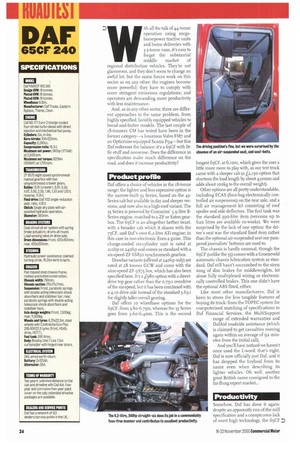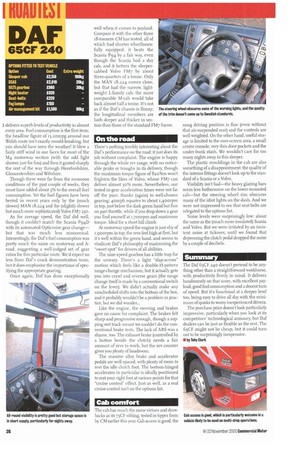DAF 65CF 240
Page 24

Page 26

Page 28

If you've noticed an error in this article please click here to report it so we can fix it.
IPRICE AS TESTED; £54,260 (ex-VAT); £46,430 basic, plus options—see box on page 26). ENGINE: 6.2 litres, 240hp (177kW). GVW: 18,000kg. BODY/PAYLOAD: 12,215kg. AVERAGE SPEED: 63.1km/h (39.2mph). AVERAGE FUEL CONSUMPTION: 13.20mpg (21.41it/100km).
ith all the talk of 44-tonne operation usirtg megahorsepower tractive units and home deliveries with 3.5-tonne vans, it's easy to forget the substantial middle market of regional distribution vehicles. They're not glamorous, and they don't seem to change art awful lot, but the same forces work on this sector as on any other: the engines become more powerful; they have to comply with more stringent emissions regulations; and operators are demanding more productivity with less maintenance.
And, as in any other sector, there are different approaches to the same problem, from highly specified, lavishly equipped vehides to bread-and-butter models. The last couple of 18-tonners CM has tested have been in the former category—a luxurious Volvo FM7 and an Opticruise-equipped Scania P94—but this Daf redresses the balance: it's a 65CF with little stuff and nonsense. Does the difference in specification make much difference on the road, and does it increase productivity?
Product profile
Daf offers a choice of vehicles in the r8-tonne range: the lighter and less expensive option is the narrow-built 55 Series, based on the 45Series cab but available in day and sleeper versions, and now also in a high-roof variant. The 55 Series is powered by Cummins' 5.9-litre 8Series engine, matched to a ZF or Eaton gearbox. The 65CF is an altogether heftier beast, with a broader cab which it shares with the 75CF, and Dais own 6.2-litre ATi engine; in this case in non-electronic Euro-2 guise. This charge-cooled six-cylinder unit is rated at 2rohp or 24ohp and comes as standard with a six-speed ZF 6S8 5o synchromesh gearbox.
Drawbar variants (offered at z4ohp only) are rated at 28 tonnes GOV and come with the nine-speed ZF 9575 box, which has also been specified here. It's a £98o option with a directdrive top gear rather than the o.79:1 overdrive of the six-speed. but it has been combined with a 4.10 drive axle instead of the standard 5.63:1 for slightly taller overall gearing.
Daf offers to wheelbase options for the 65CF, from 3.80-6.75m, whereas the 55 Series goes from 3.6o-6.4om. This is the second longest 65CF, at G.rom, which gives the user a little more room to play with, as our test truck came with a sleeper cab (a f2,15o option that shortens the load length by about 430mm and adds about rookg to the overall weight).
Other options are all pretty understandable, including EGA S (four-bag electronically controlled air suspension) on the rear axle, and a full air management kit consisting of roof spoiler and side deflectors. The fuel tank was the standard 390-litre item (versions up to 620 litres are available ex-works). We were surprised by the lack of one option: the driver's seat was the standard fixed item rather than the optional air-suspended seat our pampered journalists' bottoms are used to.
The chassis is hardly unusual, though the 65CE (unlike the 55) comes with a Groeneveld automatic chassis lubrication system as standard. Daf still hasn't succumbed to the siren song of disc brakes for middleweights, let alone fully multiplexed wiring or electronically controlled brakes. This one didn't have the optional ABS fitted, either.
Like most other manufacturers, Daf is keen to stress the less tangible features of buying its truck: from the TOP EC system for computerised matching of specifications to Daf Financial Services, the MultiSupport range of extended warranties and DafAid roadside assistance (which is claimed to get casualties moving again within an average of 92 minutes from the initial call).
And you'll have noticed we haven't once used the L-word: that's right, Daf is now officially just Daf, and it has dropped the Leyland from its name even when describing its lighter vehicles. Oh well, another great British name consigned to the far-flung export market...
Productivity
Somehow, Daf has done it again: despite an apparently run-of-the mill specification and a conspicuous lack of overt high technology, the 65CF ) delivers superb levels of productivity in almost every area. Fuel consumption is the first item: the headline figure of 13.2ompg around our Welsh route isn't exactly mould-breaking, but you should have seen the weather! It blew a fairly stiff wind in our faces for most of the M4 motorway section (with the odd light shower just for fun) and then it gusted sharply the rest of the way through Herefordshire, Gloucestershire and Wiltshire.
Though these were far from the monsoon conditions of the past couple of weeks, they must have added about 5% to the overall fuel consumption. Yet the fuel figures have been bested in recent years only by the (much slower) MAN 18.224 and the (slightly slower but much more sophisticated) Volvo FM7 250.
As for average speed, the Daf did well, though it couldn't match the Scania P94D with its automated Opticruise gear change— but that was much less economical. Interestingly, the Dais fuel consumption was pretty much the same on motorway and Aroad, suggesting a well-judged set of gear ratios for this particular route. We'd expect no less from Dais crack demonstration team, but it does emphasise the importance of specifying the appropriate gearing.
Once again, Daf has done exceptionally well when it comes to payload. Compare it with the other three i8-tonners CM has tested, all of which had shorter wheelbases: fully equipped, it beats the Scan is P94 by a fair way, even though the Scania had a day cab, and it betters the sleepercabbed Volvo FM7 by about three-quarters of a tonne. Only the MAN 18.224 comes close, but that had the narrow, lightweight L-family cab; the more comparable M-cab would take back almost half a tonne. It's not as if the Dars chassis is flimsy; the longitudinal members are both deeper and thicker in section than those of the standard FM7 frame.
On the road
There's nothing terribly interesting about the Dal's performance on the road: it just does its job without complaint. The engine is happy through the whole rev range, with no noticeable peaks or troughs in its delivery, though the maximum torque figure of 82.oNm won't frighten the likes of Volvo, whose FM7 can deliver almost 30% more. Nevertheless, our tested in-gear acceleration times were not far off the pace, thanks (again) to well-chosen gearing: 4 omph equates to about i,400rpm in top, just below the dark green band but fine on part throttle, while if you drop down a gear you find yourself at 1,700rpm and maximum torque. Ideal for a short hill climb.
At motorway speed the engine is just shy of 1,900rpm in top; the revs feel high at first, but it's well within the green band, and seems to vindicate Des philosophy of maximising the "sweet spot" for drivers of all abilities.
The nine-speed gearbox has a little trap for the unwary. There's a light -slap-across" motion which feels like a double-H-pattern range-change mechanism, but it actually gets you into crawl and reverse gears (the range change itself is made by a conventional switch on the lever). We didn't actually make any unscheduled shifts into the bottom of the box, and it probably wouldn't be a problem in practice, but we did wonder...
Like the engine, the steering and brakes gave no cause for complaint. The brakes felt sharp and progressive enough, though a sopping wet track meant we couldn't do the conventional brake tests. The lack of ABS was a shame, too. The exhaust brake (controlled by a button beside the clutch) needs a fair amount of revs to work, but the rev counter gives you plenty of headroom.
The massive alloy brake and accelerator pedals are well spaced, with plenty of room to rest the idle clutch foot. The bottom-hinged accelerator in particular is ideally positioned to rest your right foot at various points for that "cruise control" effect. Just as well, as a real cruise control isn't on the options list.
Cab comfort
The cab has much the same virtues and drawbacks as its 75CF sibling, tested in tipper form by CM earlier this year. Cab access is good, the
snug driving position is fine (even without that air-suspended seat) and the controls are well weighted. On the other hand, useful storage is limited to the over-screen area, a small centre console, very thin door pockets and the under-bunk stash. We wouldn't care for too many nights away in this sleeper.
The plastic mouldings in the cab are also something of a disappointment: the quality of the interior fittings doesn't look up to the standard of a Scania or a Volvo.
Visibility isn't bad—the heavy glazing bars seem less bothersome on the lower-mounted cab—but the steering wheel rim obscures many of the idiot lights on the dash. And we were not impressed to see that seat-belts are relegated to the options list.
Noise levels were surprisingly low: about the same as the (much more insulated) Scania and Volvo. But we were irritated by an insistent noise at tickover, until we found that depressing the clutch pedal dropped the noise by a couple of decibels.
Summary
The Daf 65C F 240 doesn't pretend to be anything other than a straightforward workhorse, with productivity firmly in mind. It delivers handsomely on that score, with excellent payload, good fuel consumption and a decent turn of speed. But it's functional at a deeper level too, being easy to drive all day with the minimum of quirks to worry inexperienced drivers.
The purchase price doesn't look particularly impressive, particularly when you look at its competitors' technological armoury, but Daf dealers can be just as flexible as the rest. The 65CF might not be cheap, but it could turn out to be surprisingly inexpensive.
IN by Toby Clark








































































































